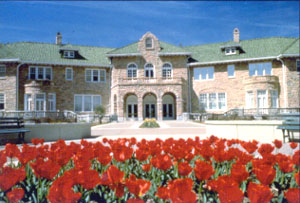
Pink Palace Museum, Memphis
The Pink Palace is both a house and a museum. In 1922 Clarence Saunders, the father of self-service grocery shopping and founder of Piggly Wiggly, began building a mansion. Memphians called his 36,500-square-foot house, faced with pink Georgia marble, his “Pink Palace,” and the name stuck. In 1923 he lost a battle on the New York Stock Exchange, was forced to declare bankruptcy, and never finished his house. The land was sold to developers. The unfinished mansion was donated to the City of Memphis, which turned it into a museum. It opened in March l930 as the Memphis Museum of Natural History and Industrial Arts. The public, though, still called it “the Pink Palace,” and in 1967 the museum formally became the Memphis Pink Palace Museum.
Its early exhibits featured a collection of North American game animals, stuffed fish, and the remarkable Boshart collection of eight hundred taxidermied birds. For several decades the museum’s collections could best be described as eclectic, as the staff accepted almost any artifact someone offered. Today’s museum exhibits focus on the cultural and natural history of the Memphis region, interpreting the history of Memphis, medicine in the Mid-South, and the geology and wildlife populations of the area. There is a replica of the first Piggly Wiggly grocery store, a turn-of-the-century country store, and the hand-carved, automated Clyde Parke Circus.
The mansion has been renovated and contains exhibits on the history of Memphis in the twentieth century and the evolution of the museum. One wing houses the Entrepreneur Hall of Honor, which salutes Memphians who have had an impact on business worldwide. After several expansions, the museum now contains over 170,000 square feet, making it one of the largest in the Southeast. In addition to the permanent collection, there are regularly scheduled traveling exhibits. The Sharpe Planetarium and the Union Planters IMAX Theater also enhance the museum’s role and audience.
In addition to the Pink Palace, the Pink Palace Family of Museums includes two nineteenth-century historic properties, the Magevney and Mallory-Neely Houses, and the Lichterman Nature Center in Memphis, as well as the Coon Creek Science Center in McNairy County, a major invertebrate fossil-collecting site and education facility.



